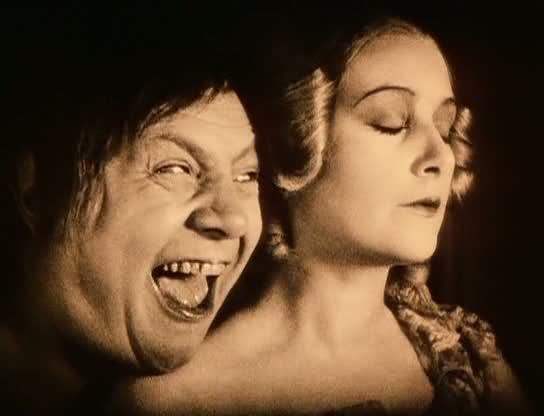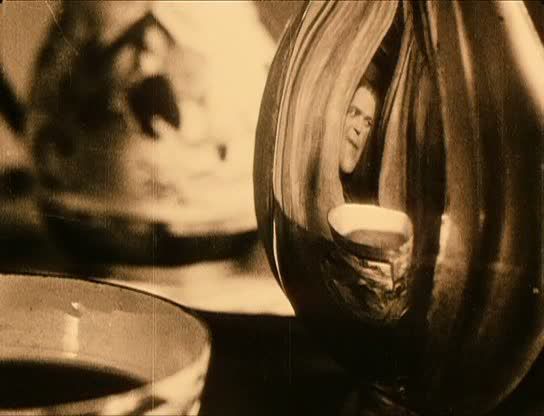
F.W. Murnau followed the daring, innovative masterpiece The Last Laugh with a much more modest, smaller-scale, but still interesting feature, his clever adaptation of Molière's Tartuffe. Murnau increases the distance from Molière's satire by making the actual Tartuffe story a film within the film, surrounded by a framing story that mirrors the one in the Molière tale. In this framing story, a young man (André Mattoni) is disinherited by his grandfather (Hermann Picha) because the old man disapproves of his grandson's choice of profession: a film actor. The old man is under the influence of a nasty housekeeper (Rosa Valetti), who's literally and metaphorically poisoning the old man and convincing him to change his will to make her the beneficiary rather than the grandson. It's a story that neatly mirrors Tartuffe, so the grandson, to convince his grandfather of the housekeeper's manipulation, disguises himself as a traveling projectionist and shows them both a film of Tartuffe.
This is the film within the film, in which Emil Jannings plays the titular con man, a religious preacher who convinces the wealthy Orgon (Werner Krauss) to shun material goods, even pushing away the affections of his wife (Lil Dagover) and eventually writing Tartuffe into his will. The choice to position this adaptation in this fashion, as a film within the film, is interesting because Tartuffe is all about exposing hypocrites, and for Murnau, whose films were almost always firmly grounded in moral messages, a primary vehicle for exposing hypocrisy and evil was of course the cinema. It's telling that the hero grandson of the framing story earns disapproval for pursuing a career in film acting, and yet it's through film that he exposes the evil of the housekeeper, delivering a fable that helps open the old man's eyes to the similar situation going on in his own film. Murnau opens and closes the film with text titles that implicitly direct the audience to similarly look for hypocrisy in their own experiences, thus extending the film's reach to a further layer.
Jannings, as always, delivers a stunning performance as the sinister Tartuffe, doing maybe too good of a job at evoking the false priest's slack-faced, dour malice, because he's such a horrible, vile creation that it's hard to believe that anyone could fall under his influence. He's continually scowling, his face always crooked: one eye bulging and another slitted, one corner of his mouth drooping below the other. His very face reflects his unbalanced, crooked nature, a hideous mask of menace, always frowning with disapproval and judgment, even as he secretly indulges in his own lusty appetites. This leads Orgon's wife Elmire to attempt a clever plan to seduce the manipulator, exposing him as a fraud by revealing his base, fleshy appetites. In one scene between them, Tartuffe disingenuously scolds Elmire while thrusting the edge of a bible against her cleavage, the holy book's proximity to the woman's ample breast enforcing the hypocrisy of this supposed holy man who denies the pleasure of others while illicitly thirsting for his own pleasure.

Murnau infuses these scenes with a strange eroticism, because eroticism is very much what's at stake in this story: when Orgon first returns home under the influence of Tartuffe, he won't even kiss his wife, who's obviously used to much more sensual and affectionate welcomes. And it's eroticism that eventually wins this game, as Elmire bares her shoulders and her cleavage for the monstrous Tartuffe, throwing her head back and caressing herself to break through his hypocritical façade of chaste religious devotion. Murnau shoots from a high angle, looking down on the woman as she reluctantly stretches and bares her skin to entice Tartuffe into betraying his denial of worldly pleasures.
Although this film is far simpler and more direct than Murnau's more elaborate expressionist masterpieces like The Last Laugh or Faust, it's still very visually expressive and evocative. Murnau's visual inventiveness is revealed in small but telling touches. Elmire, grieving over her husband's wayward devotion to the trickster Tartuffe, stares at a portrait of Orgon in a locket and cries over him, the tears falling on the picture and distorting it, creating a warped vision of Orgon that looks more like the melty-faced Tartuffe himself. Later, that prophecy seems to come true in the scene where Orgon spies on Tartuffe with Elmire, and the con man catches on to the trap by glimpsing Orgon's distorted, elongated face reflected in a coffee pot, staring out from between the curtains behind Tartuffe.
The film sticks to a few minimalist, claustrophobic sets, and Murnau fills them with dense shadows, the house encased in darkness because the spartan Tartuffe despises luxuries like lights. This provides an opportunity for striking shots like the one where the family's maid creeps up the stairs holding a candle, her profile extended onto the wall in front of her. Though Tartuffe is never as visually sumptuous or restlessly inventive as Murnau's best work, these kinds of striking images make it still an interesting, low-key film. It's also notable as Murnau's tribute to his chosen medium, positioning the Molière tale in a framework that confirms the cinema's power to explore morality and affect viewers' minds and hearts.
No comments:
Post a Comment